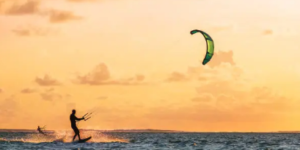Kiteboarding is a sport that involves flying and riding a kite while standing on a board. The most important aspect of learning to kite is controlling the kite, a task that can be discovered on land with the help of an instructor.
 Power up refers to increasing energy harvesting by moving the kite in an S-shaped path that traverses a large volume of atmosphere. Your instructor will explain this concept in detail. For professional kite boarding services, check this out.
Power up refers to increasing energy harvesting by moving the kite in an S-shaped path that traverses a large volume of atmosphere. Your instructor will explain this concept in detail. For professional kite boarding services, check this out.
Wind Conditions
One of the most crucial factors for kiteboarding is wind conditions. There is too little wind, and you won’t be able to launch the kite and have fun riding it. If there is too much wind, you may get overpowered and struggle to maintain control.
Depending on the kite size, different manufacturers will suggest a minimum wind speed for their kites. A good idea is to check the wind speed with an anemometer, which can be found at most kite schools and rentals.
Another factor is the direction of the wind, either onshore or offshore. Onshore winds are best for beginners and experts who can ride upwind easily, while offshore winds are hazardous and require advanced management skills. Offshore winds push riders out to sea, and they need a rescue boat to return to land safely.
Board
In kiteboarding, the wind is used to power a board, which varies in shape and size depending on what discipline a rider prefers. Twin tip boards are the most common type and ideal for beginners. Directional boards and hydrofoil boards are also famous for riders who like to ride waves or experience the feeling of being airborne. For professional kite boarding services, check this out.
Any large body of water, such as lakes, lagoons, rivers, oceans, or even pools (don’t try this at home), becomes a potential playground for kiters. Flat waters are ideal for learning the basics, while more experienced riders enjoy choppy or wavy waters that can be used to hop and jump.
Kite
The kite is a large surface that harvests the wind from the atmosphere. It has lines that connect the rider to the kite through a control bar. The bar is attached to a harness, and the lines are typically adjustable from 5 to 24 meters long, depending on the model of the kite.
The size of the kite depends on the wind range and the rider’s weight. Most riders will eventually own two or more kites for different wind conditions.
Kites can also be maneuvered in a variety of ways to increase power. For example, a kite can be flown in an S-shaped path to generate more lift because it traverses a larger volume of atmosphere. Another technique is called a kite loop. It is a more advanced practice and requires more skill and knowledge of the kite.
Harness
The harness transfers the load from the kite to your body and creates a centre of gravity for steering. It also provides a safety connection with the kite.
Modern harnesses usually come with a line cutter stored under the spreader bar (to cut any lines that might wrap around your limbs quickly), as well as a leash connector and a chicken loop (fixed hook) to attach it to the control bar. Some are padded, and some are waist only. Dakine is a famous manufacturer of harnesses, and they have an extensive range. For professional kite boarding services, check this out.
The control bar has 2 or 3 lines attached to it, including the primary safety system that works by pushing away from the harness to open the “chicken loop” and decrease the power of your kite. The bar may also have foam “bar floats” fixed to it to keep the bar from sinking in case of loss or damage.
Safety
Kite surfing is a dangerous sport, and most accidents occur when the person is lofted or dragged and crashes with complex objects such as water, buildings, terrain or power lines. Collisions with other kiteboarders or watercraft are also common, and the most severe injuries are dislocated shoulders, sprained ankles and cracked ribs.